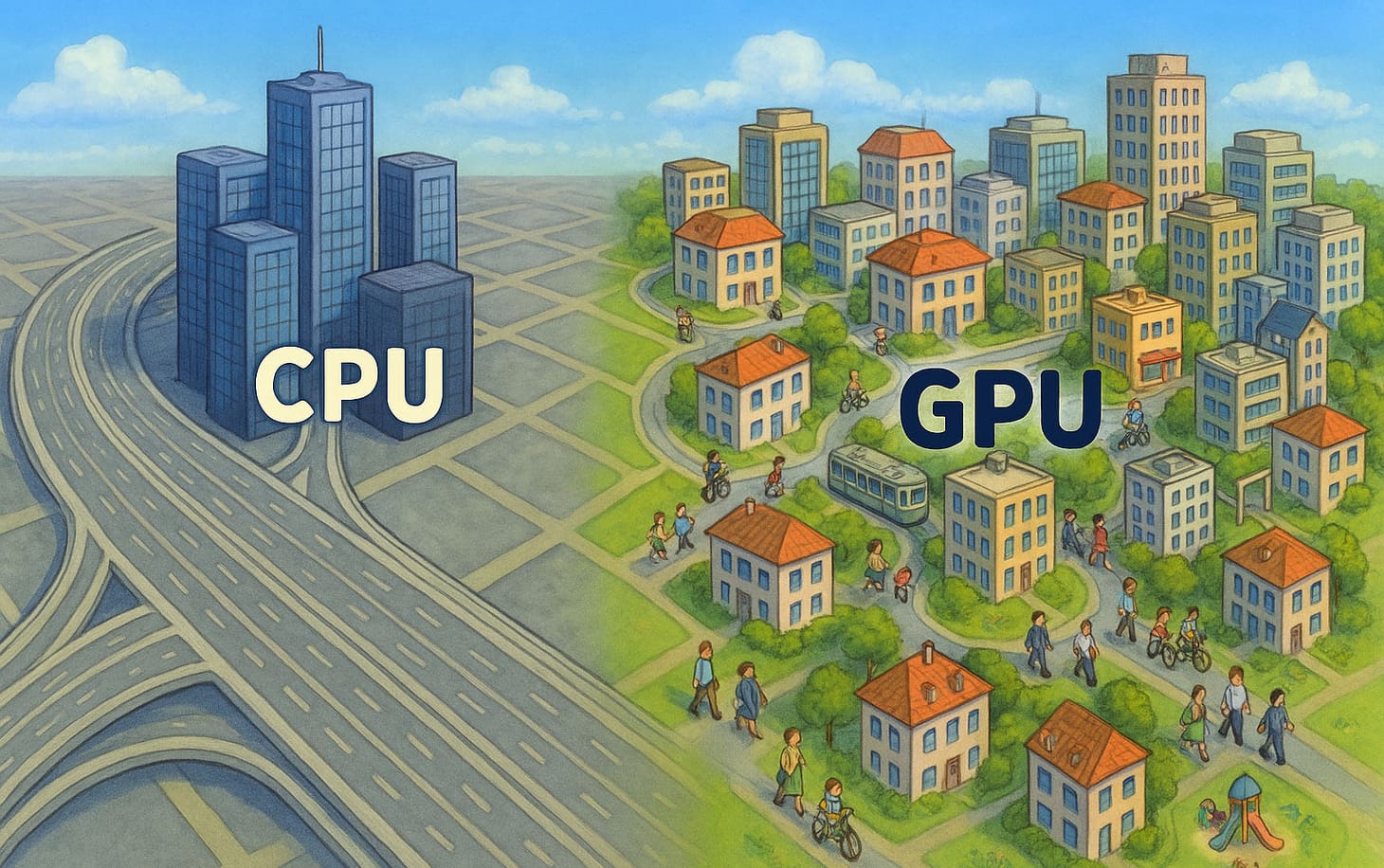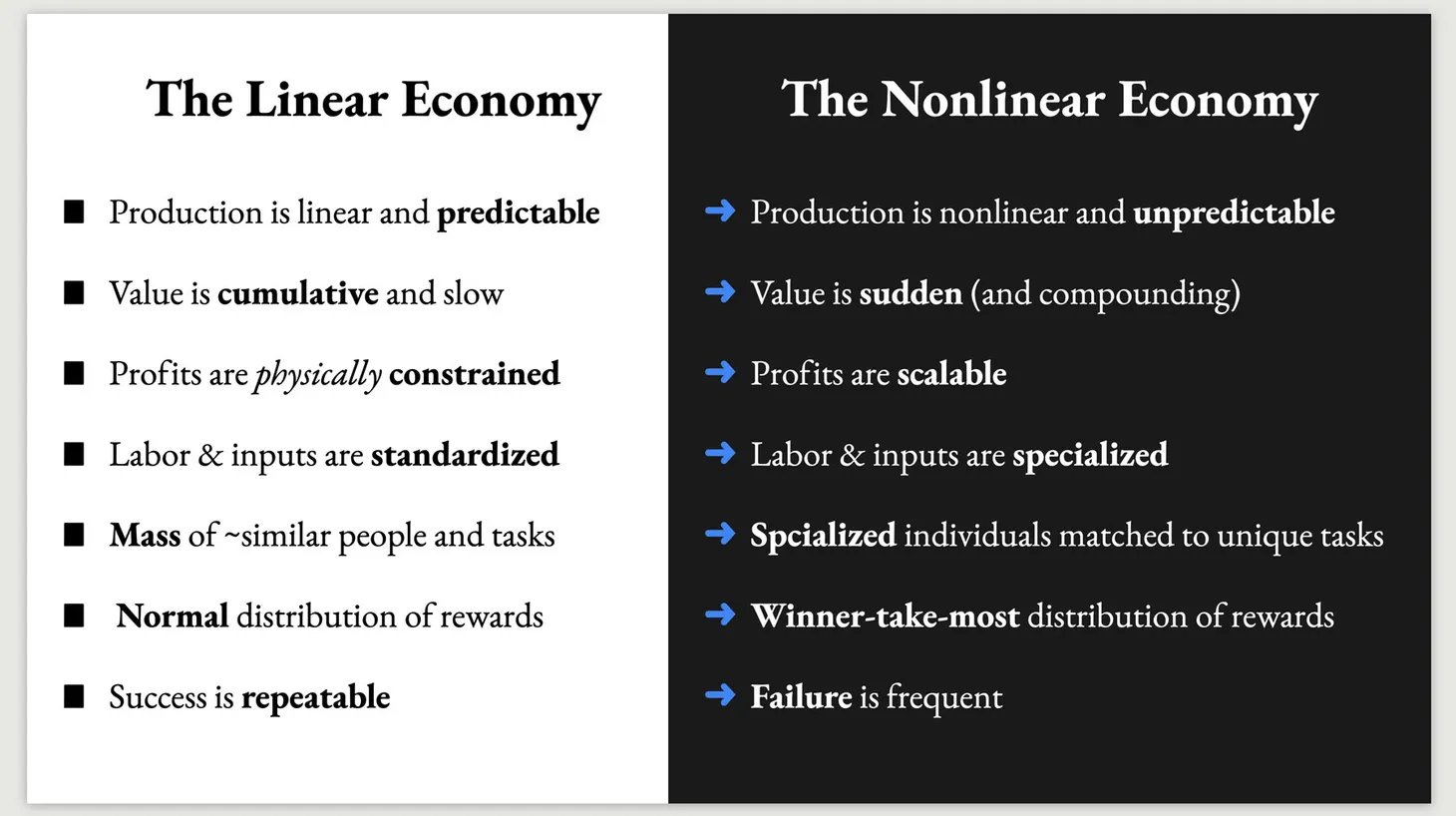General Purpose Urbanism
Our cities and offices must learn from the architecture of AI models.

There is a mismatch between our economy and the world we built around it. Our cities and offices were shaped by industrial assumptions: fixed schedules, masses of identical people performing identical tasks, a stable and predictable relationship between inputs and outputs.
I wrote about the origins of this mismatch in The Nonlinear Economy. The rise of artificial intelligence is intensifying it by injecting uncertainty into all industries and professions, by enabling fewer people to do more with less, and by making more products and environments dependent on software.
What does it mean for our cities and workplaces?
The environment and ideas of each era are shaped by its dominant technology. In the Late Middle Ages, mechanical clocks towered over towns, dividing the day into regular, predictable intervals. By the early modern era, clocks had become a common metaphor, influencing how business, bureaucracies, and armies were structured and operated. They sparked a transition from task-based labor towards hourly wages that became standard in the 20th Century.
Modern cities mirrored their factories — rigid, standardized, and mechanistic, with designated zones for specific functions. This approach extended naturally to the first wave of large offices and computers. IBM's “International Business Machines” processed information in the same predictable, linear manner as industrial machines processed raw materials. Modern cities evolved to accommodate these systems, designed for predictable flows of similar employees into similar workplaces to perform similar tasks.
Today, the machines are less rigid, less predictable, and far more adaptable. The old relationship between inputs and outputs no longer holds. This creates a profound mismatch. It also presents a powerful new metaphor to guide our thinking about cities, companies, and careers.
Consider the architecture of ChatGPT. Unlike traditional software, ChatGPT does not process information based on a linear set of instructions. Instead, it makes educated guesses about the most likely sequence of words that should appear after whatever users wrote. For example, “Transformer” systems (the T in ChatGPT) are trained to recognize that the word “Good” is often followed by the word “morning” and that the word “cold” often appears within 500 words of the word “Sweden.” By reading billions of lines of text, the system develops a vast map of probabilities enabling it to expand — or transform — any query into a coherent, relevant answer. Incredibly, this nonlinear approach often produces insights that rival those of human experts.
The nonlinear nature of OpenAI’s software model is mirrored in the hardware it runs on. Traditional software relies on CPU chips that conduct difficult calculations sequentially, processing lines of code one step at a time. ChatGPT, in contrast, runs on GPU chips that were originally developed for computer game graphics. Unlike CPUs, GPU chips conduct many simpler calculations in parallel. The difference is akin to that between a jet airplane and a swarm of bees. If you know exactly where you’re going, the jet will get you there faster in a straight line. But if you’re unsure, the swarm can explore different directions simultaneously. The swarm can also coalesce and disperse quickly, adapting to uncertainty.
Just as computing shifted from CPUs — rigid, predictable, and sequential — to GPUs — flexible, probabilistic, and exploratory — our cities need the same transformation. It’s time to move from Central Purpose Urbanism (CPU) focused on giant office buildings, fixed routines, and static separation between different activities to General Purpose Urbanism (GPU), which enables people and businesses to try out and discover new ways to live and work — and to coalesce and disperse quickly, as necessary.
Cities offer the most vivid illustration of this broader shift because they sit at the intersection of every economic and social force shaping our lives. But the same is true for our companies, careers, and conflicts. Instead of rigidly planning for outcomes we think we can foresee, we need spaces and systems explicitly designed for uncertainty, experimentation, and adaptation. The goal is not to predict the future, but to embrace a world that is reliably unpredictable, out of proportion, and volatile. The alternative is stagnation followed by collapse: rigid cities that can’t evolve, companies that can’t innovate, and careers that can’t adapt.
What does this shift from Central Purpose Urbanism (CPU) to General Purpose Urbanism (GPU) mean in practice?
I asked Claude.ai to summarize my recent talk on this topic: Just as GPU chips have multiple cores that enable parallel processing, GPU cities would feature multiple vibrant centers rather than a single dominant business district. These cities would prioritize flexibility, adaptability, and experimentation over rigid planning and fixed functions.
At its most basic level, General Purpose Urbanism requires spaces that enable people to experiment cheaply and quickly. This means more flexible workspaces like coworking spaces, libraries, and coffee shops that can accommodate a variety of activities and working styles. But it also means ensuring the basic necessities of life — abundant housing, efficient transportation, and essential services — that allow people to survive and thrive during periods of uncertainty and experimentation.
Tokyo offers perhaps the best existing model of a GPU city. Unlike New York or London, where land use is strictly defined and/or change happens slowly, Tokyo's zoning focuses more on a building's physical impact than on dictating its purpose. This approach enables rapid adaptation: a restaurant can become a shop, a shop can become an office, and an office can become a residence with minimal bureaucratic friction.
The city's polycentric structure is equally impressive. Anyone who has traveled the Yamanote train line knows that its 30 stations stop at multiple cores, each as vibrant as central Manhattan and with its own distinct character. Beyond these major nodes lies a constellation of smaller cores, creating a vast urban network that offers both high flexibility and fast change.
But how do we reconcile such dynamism with the need for stable infrastructure? Here, we can look to Excel as a metaphor — it provides powerful infrastructure but remains completely open about what you build within it. It gives you the physical spaces and the functions, and leaves you to fill them with content (and then edit that content as necessary). Like software, Tokyo excels (...) by constructing reliable transportation infrastructure while communicating plans well in advance so that people and businesses can adapt accordingly. Within these frameworks, people have remarkable freedom to innovate and experiment. And even Tokyo could be much better.
For maximum adaptability, cities need multiple scales of transportation: not just subways that might take 15 years to build, but also buses and bicycle networks that can create new connections organically and respond more quickly to changing patterns of movement and activity.
Beyond their physical and economic functions, GPU cities must also strengthen their social fabric. In a world defined by uncertainty and volatility, cities need to provide protection, warmth, and connection. They must be safer and more affordable while leveraging their density to provide public goods efficiently. A truly flexible city isn't just about enabling business experimentation — it's about nurturing communities that help people weather change and thrive amid unpredictability.
The cities that will succeed in the nonlinear economy won't be those that optimize for a single, predictable future, but those that create the conditions for multiple futures to emerge and evolve. They will be more like living organisms than machines—complex, adaptive systems capable of responding to the surprises that inevitably lie ahead.
The relevant excerpt from my talk can be seen below:
The concept of General Purpose Urbanism is still fresh and raw. I'd love to hear your thoughts.
Best,

🎤 How will AI reshape our cities, companies, and careers? My speaking schedule for the spring is filling up. Visit my speaker profile and get in touch to learn more.
Dror Poleg Newsletter
Join the newsletter to receive the latest updates in your inbox.




